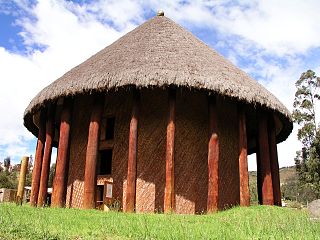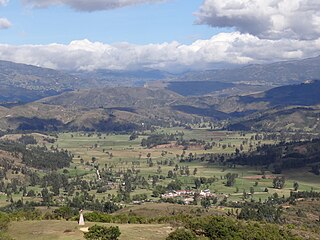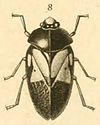
The Muisca are an Indigenous people and culture of the Altiplano Cundiboyacense, Colombia, that formed the Muisca Confederation before the Spanish conquest. The people spoke Muysccubun, a language of the Chibchan language family, also called Muysca and Mosca. They were encountered by conquistadors dispatched by the Spanish Empire in 1537 at the time of the conquest.

Iza is a town and municipality in Boyacá Department, Colombia. Iza is located near the Tota Lake and part of the Sugamuxi Province, a subregion of Boyacá. Iza is located in the Eastern Ranges of the Colombian Andes on the Altiplano Cundiboyacense at a distance of 13 kilometres (8.1 mi) from Sogamoso and 90 kilometres (56 mi) from the department capital Tunja. The municipality borders Firavitoba and Sogamoso in the north, Sogamoso and Cuítiva in the east, in the west Pesca and Firavitoba, and in the south Cuítiva.

The Altiplano Cundiboyacense is a high plateau located in the Eastern Cordillera of the Colombian Andes covering parts of the departments of Cundinamarca and Boyacá. The altiplano corresponds to the ancient territory of the Muisca. The Altiplano Cundiboyacense comprises three distinctive flat regions; the Bogotá savanna, the valleys of Ubaté and Chiquinquirá, and the valleys of Duitama and Sogamoso. The average altitude of the altiplano is about 2,600 metres (8,500 ft) above sea level but ranges from roughly 2,500 metres (8,200 ft) to 4,000 metres (13,000 ft).

Sativasur is a town and municipality in the Colombian Department of Boyacá, part of the subregion of the Northern Boyacá Province. It is approximately 132 km from Tunja, the capital of the department. Sativasur borders the municipalities Sativanorte in the north, Socotá in the east and Paz de Río in the south and west.

Tasco is a town and municipality in the Valderrama Province, part of the Colombian department of Boyacá. Tasco is situated on the Altiplano Cundiboyacense at altitudes ranging from 2,400 metres (7,900 ft) to 3,800 metres (12,500 ft). The Chicamocha River flows through the municipality which borders Socha in the north, Corrales and Gámeza in the south, Socotá in the east and Betéitiva and Paz de Río in the west. The urban centre is located at an altitude of 2,530 metres (8,300 ft) at 115 kilometres (71 mi) from the department capital Tunja.

Guatavita is a municipality and town of Colombia in the Guavio Province of the department of Cundinamarca. Guatavita is located 75 km northeast of the capital Bogotá. It borders Sesquilé and Machetá in the north, Gachetá and Junín in the east, Guasca in the south and in the west are Tocancipá and Gachancipá.

The Bogotá savanna is a montane savanna, located in the southwestern part of the Altiplano Cundiboyacense in the center of Colombia. The Bogotá savanna has an extent of 4,251.6 square kilometres (1,641.6 sq mi) and an average altitude of 2,650 metres (8,690 ft). The savanna is situated in the Eastern Ranges of the Colombian Andes.

Bacatá is the name given to the main settlement of the Muisca Confederation on the Bogotá savanna. It mostly refers to an area, rather than an individual village, although the name is also found in texts referring to the modern settlement of Funza, in the centre of the savanna. Bacatá was the main seat of the zipa, the ruler of the Bogotá savanna and adjacent areas. The name of the Colombian capital, Bogotá, is derived from Bacatá, but founded as Santafe de Bogotá in the western foothills of the Eastern Hills in a different location than the original settlement Bacatá, west of the Bogotá River, eventually named after Bacatá as well.

Idacansás, Idacansas, Idacanzas or Iduakanzas was a mythical cacique who was said to have been the first priest of the sacred city of Sugamuxi, present-day Sogamoso, Colombia, then part of the territories of the Muisca. He is characterized by his great magical powers as he could make rain and hail and transmit diseases and warmth.

Huitaca or Xubchasgagua was a rebelling goddess in the religion of the Muisca. The Muisca and their confederation were a civilization who inhabited the Altiplano Cundiboyacense in the Andes. Huitaca has been described by the chroniclers Juan de Castellanos in his Elegías de varones ilustres de Indias, Lucas Fernández de Piedrahita and Pedro Simón.
Brachygasterina muisca is a species of fly in the genus Brachygasterina of the subfamily Muscinae, described in 2012 by Soares and De Carvalho.

The iraca, sometimes spelled iraka, was the ruler and high priest of Sugamuxi in the confederation of the Muisca who inhabited the Altiplano Cundiboyacense; the central highlands of the Colombian Andes. Iraca can also refer to the Iraka Valley over which they ruled. Important scholars who wrote about the iraca were Lucas Fernández de Piedrahita, Alexander von Humboldt and Ezequiel Uricoechea.

The Battle of Pasca was fought between the southern Muisca Confederation, led by their zipa (ruler), Saguamanchica, and an alliance between the Panche and the Sutagao, led by the Cacique of Fusagasugá. The battle took place c. 1470 in the vicinity of Pasca, in modern-day Cundinamarca, Colombia, and resulted in a victory for Saguamanchica.

This article describes the astronomy of the Muisca. The Muisca, one of the four advanced civilisations in the Americas before the Spanish conquest of the Muisca, had a thorough understanding of astronomy, as evidenced by their architecture and calendar, important in their agriculture.

This article describes the role of women in Muisca society. The Muisca were the original inhabitants of the Altiplano Cundiboyacense before the Spanish conquest in the first half of the 16th century. Their society was one of the four great civilizations of the Americas.

Lake Fúquene is a heart-shaped lake located in the Ubaté-Chiquinquirá Valley, part of the Altiplano Cundiboyacense, in the north of Cundinamarca, Colombia, at the border with Boyacá. The Andean lake, at an average altitude of 2,540 metres (8,330 ft), was considered sacred in the religion of the Muisca who inhabited the area before the Spanish conquest of the Muisca in the 1530s.

This article describes the warfare of the Muisca. The Muisca inhabited the Tenza and Ubaque valleys and the Altiplano Cundiboyacense, the high plateau of the Colombian Eastern Ranges of the Andes in the time before the Spanish conquest. Their society was mainly egalitarian with little difference between the elite class (caciques) and the general people. The Muisca economy was based on agriculture and trading raw materials like cotton, coca, feathers, sea snails and gold with their neighbours. Called "Salt People", they extracted salt from brines in Zipaquirá, Nemocón and Tausa to use for their cuisine and as trading material.

This article describes the art produced by the Muisca. The Muisca established one of the four grand civilisations of the pre-Columbian Americas on the Altiplano Cundiboyacense in present-day central Colombia. Their various forms of art have been described in detail and include pottery, textiles, body art, hieroglyphs and rock art. While their architecture was modest compared to the Inca, Aztec and Maya civilisations, the Muisca are best known for their skilled goldworking. The Museo del Oro in the Colombian capital Bogotá houses the biggest collection of golden objects in the world, from various Colombian cultures including the Muisca.
Euryomma muisca is a species of fly in the genus Euryomma. It was first described by Grisales et al. in 2012.

























